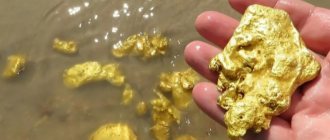According to data released by the World Gold Council (WGC), global gold production in 2022 was 3,478.1 tonnes (122.7 million ounces).
Volumes have declined for the second year in a row. In 2022, this figure was 3,561.3 tons, in 2022 - 3,533.7 tons.
“Experts believe that one of the reasons for the decline in gold production in the world is the negative impact of the new coronavirus pandemic on the economy,” says Top-RF.ru columnist Svetlana Baruzdina.
In addition, the budgets allocated by companies for geological exploration are being reduced.
Against this background, the list of countries included in the top 10 gold mining rankings has also changed in 2022.
See also: - 10 jewelry stores in Russia: favorite brands and manufacturers >>
Uzbekistan – 90 tons
Uzbekistan is one of only two landlocked countries bordering landlocked countries in the world, but that doesn't mean it doesn't have important natural resources (although there are definitely problems with exporting them ). This country took tenth place in the ranking of the most gold-mining countries, as about 90 tons of gold are mined here per year. Most of the gold that is mined here is then nationalized, and it belongs to the Navoi Mining and Metallurgical Combine.
Which country comes first?
Useful articles
Gold rate for today: online quotes chart + analytics and forecast
Russia's gold and foreign exchange reserves today: is there any cause for concern?
Investments in metals: is it really profitable to invest in gold?
For several years now, the undoubted leader has been China. About 15% of all ore in the world is mined here. This is explained both by politics and the desire to strengthen the currency, and by favorable rock development, new mines. Experts predict the country’s leading position for at least another 15 years.
Indonesia – 100 tons
It’s better not to neglect hygiene: what happens if you don’t brush your teeth for more than a day?
Biology, physics and computer science: the most popular elective subjects of the Unified State Exam in 2021
The greatest comedian of all time: what happened to the 3 sons of Louis de Funes
While you can find the largest open-pit gold mine in the world in Uzbekistan, the record for the largest gold mine belongs to Indonesia. We are talking about the Grasberg mine, where 19 thousand people work. Unfortunately, it is also considered one of the most toxic places in the world. Each year, this mine releases about a thousand tons of mercury into the atmosphere in addition to the fact that 100 tons of gold are mined here annually. People who live near this mine eat fish that contain twice the recommended amount of mercury, meaning that gold mining is an extremely harmful process for the mine workers and those who live nearby.
What is gold and what is it used for?
Gold is a noble metal of yellow color. This metal is very highly valued by people and is one of the most expensive among other metals. The high cost of the metal is largely due to its rarity in nature. Although the metal is actually not that rare, since it is found in small quantities almost everywhere. So gold can be found in the earth's crust, it is contained in sea and river water. However, the gold mining process itself is extremely labor-intensive and requires a large amount of work. To get just one ounce of gold, you need to process about 3 tons of ore.
Gold reserves on Earth are insignificant relative to other metals. Gold has good preservation properties. Throughout world history, gold has rarely been lost and has always been melted down and accumulated again. All this allowed gold to become an important element of the economy and financial system of many countries. Nowadays, gold is used as an important way of investing and accumulating capital. Often, investors invest their savings in this asset during periods of economic instability. Gold is also actively used by countries around the world in the formation of the country's gold reserves and gold and foreign exchange reserves. However, gold has a number of other applications in economics, investment and trade - jewelry, medicine, modern industry and others.
Gold is the most popular metal in the manufacture of jewelry metals. However, gold itself is a very soft metal, and when making jewelry, other metals are added in addition to gold to make it harder. Most often, zinc, copper, silver, platinum, palladium and other non-ferrous metals are added when making jewelry.
Due to its metallic properties (malleability, ductility, resistance to aggressive environments), gold is actively used in modern industry in the manufacture of ultra-thin products, for example, in the manufacture of modern electronics - processors, various circuit boards, etc. In addition, gold is used in aviation, nanotechnology, chemical industry and other industries. Gold is even used in nuclear energy.
Due to its low oxidation, gold has found extensive use in dentistry. The precious metal is also used in some medicines for the treatment of tuberculosis, arthritis and cancer.
Ghana – 100 tons
Ghana was once known as the Gold Coast for its abundance of metals. In 2011, 100 tons of gold were mined here, but the gold reserves are gradually decreasing, and today Ghana's gold reserves are estimated at only 1,400 tons. The gold mining industry accounts for about five percent of the country's GDP, and mined minerals account for 37 percent of the country's exports. Ghana is the second largest gold producer in Africa, second only to South Africa.
There will be a large harvest of tomatoes even without seedlings: a selection of the right varieties
The miracle fruit turned out to be even more wonderful: scientists learned about new properties of avocado
It turns out that a person is able to count in his sleep: new research
Rating of countries in the world by gold production
(according to the World Gold Council (WGC) for 2022)
| № | A country | Gold production volume, tons |
| 1 | China | 368.3 |
| 2 | Russia | 331.1 |
| 3 | Australia | 327.8 |
| 4 | USA | 190.2 |
| 5 | Canada | 170.6 |
| 6 | Ghana | 138.7 |
| 7 | Brazil | 107.0 |
| 8 | Uzbekistan | 101.6 |
| 9 | Mexico | 101.6 |
| 10 | Indonesia | 100.9 |
Show more ↓.
| № | A country | Gold production volume, tons |
| 11 | South Africa | 99.2 |
| 12 | Peru | 97.8 |
| 13 | Mali | 93.8 |
| 14 | Burkina Faso | 93.4 |
| 15 | Sudan | 83.8 |
| 16 | Kazakhstan | 78.4 |
| 17 | Congo | 60.9 |
| 18 | Guinea | 56.9 |
| 19 | Colombia | 53.6 |
| 20 | Papua New Guinea | 53.1 |
| 21 | Tanzania | 45.9 |
| 22 | Türkiye | 42.0 |
| 23 | Ivory Coast | 41.9 |
| 24 | Zimbabwe | 40.9 |
| 25 | Argentina | 36.7 |
| 26 | Venezuela | 33.4 |
| 27 | Chile | 32.1 |
| 28 | Suriname | 29.8 |
| 29 | Dominican Republic | 28.3 |
| 30 | Philippines | 25.4 |
| 31 | Kyrgyzstan | 24.3 |
| 32 | Mongolia | 20.2 |
| 33 | Guyana | 18.2 |
| 34 | Senegal | 15.8 |
| 35 | Mauritania | 15.6 |
| 36 | Egypt | 14.1 |
| 37 | Ecuador | 13.5 |
| 38 | Iran | 10.5 |
| 39 | Ethiopia | 10.0 |
| 40 | Nicaragua | 8.9 |
According to the World Gold Council (WGC).
Canada - 110 tons
Ah, Canada, land of snow, oil and precious metals. Most of Canada's gold comes from Ontario, specifically the Red Lake mine. Canada is so patriotic about its own gold that you can purchase a Canadian gold coin for just a few hundred dollars. However, you need to hurry because the country's gold mines are among the smallest among the countries on this list.
Peru – 150 tons
Peru is the largest gold-producing country in Latin America and only the second largest in all of America after the United States. Although the country receives some monetary profit from gold mining, the process has a negative impact on the environment. Over the past decade, gold mining in this country has increased by 400 percent, and this has had an extremely negative impact on the Peruvian Amazon. The problem with Peruvian gold mines is that most of them are located on top of mountains, so the mountains themselves and the surrounding land are negatively impacted.
A British cruise ship appears to be floating above the water: an optical illusion
Giraffes have no problems with blood pressure: the long-necked gene will help people with hypertension
Israel plans to reopen: the best places to visit in this country
South Africa - 190 tons
The country that produces the most gold on the African continent is South Africa, receiving about 190 tons of gold per year. The most striking fact about gold mining in South Africa is that the country still has about six thousand tons of gold in reserve. In addition, until 2006, this country was considered the largest gold miner in the world, and although it still remains in a high position, its operating efficiency is not the highest. Gold mining is one of the key driving factors allowing South Africa to actively participate in the global economy.
Gold mining in the world
World gold mining began from time immemorial. Thousands of years have passed since then, but mining methods have hardly changed. In the developed 21st century, the method of washing river sand continues to be used. Yellow metal began to be mined using a closed method in the Renaissance (approximately the 16th-17th centuries), when the necessary technical means appeared.
Gold mining by soil leaching
The valuable resource is extracted by amalgamation and chlorination. About 40% of the extracted resource is smelted into ingots, the rest is used for the manufacture of jewelry (about 50%) and technical needs (about 12%).
List of leading countries in gold mining:
- China – 12.9%;
- Australia – 9.5%;
- South African Republic – 9%;
- USA – 8.9%;
- Russia – 8%;
- Peru – 7.5%;
- Uzbekistan – 6.2%.
In 2015, the world produced about 2,654 tons, which was 4% more than in 2014 (2,549 tons). It is worth noting that the indicators for mining and production volumes are very different, since recycled materials are used in production - gold-containing scrap.
The leader in gold production is Russia, which increased its output of finished products by almost 13% in 2014-2015. Also in the Russian Federation they continue to increase the pace of not only production, but also the extraction of precious metal. Growth began around 2008.
Russia – 200 tons
It is not surprising that Russia got a lot of gold, since it occupies approximately one-sixth of the entire world's territory. More than five thousand tons are still in reserve, much of it has not yet even begun to be mined, particularly in eastern Siberia, but Russia has already begun importing gold to quench its thirst for the shiny metal. For example, in 2012, the country imported approximately five percent of gold to replenish its bank reserve, which stands at about 900 tons. Whether the metal is in a jar or underground, Russia definitely loves gold.
Using a radio telescope, astronomers looked at the “cosmic jellyfish” for the first time
NASA discovered a snake-like exoplanet with its own atmosphere
What does Sergei Yursky's daughter do: she looks very much like him (new photos)
M&A transactions
Another effect can be considered the intensification of mergers and acquisitions. Thus, the largest deal in the industry was completed - the merger of the American Newmont Mining and the Canadian Goldcorp for $12.3 billion (according to the Institute of Geotechnology). The previous record was a year earlier - the merger of Barrick Gold and Randgold Resources, a deal worth $5.4 billion.
These transactions, notes Mikhail Ivanovich, became an impetus for corporate activity - in 2020 it was the highest in many years. In Russia, the most discussed deal was Kinross Gold’s purchase of the Chulbatkan deposit from a junior company. This is a major and so far unique event in our market: the acquisition by a major of an object from a junior for a large sum.
The deal shook up the market, demonstrating that there is a junior movement in the country and that Russian private exploration companies are working at a very high level. Analysts expect this event to trigger a number of changes in the structure of the approach to exploration in the country.
In addition, PIK acquired the Darasun gold mine and the Highland Gold company, Yuzhural-Zoloto became the owner of a large stake in Petropavlovsk, and Amur Gold made a very unusual RTO transaction (the so-called “reverse takeover transaction”) with the Swedish Kopy Goldfields is a junior working in Russia. Mikhail Leskov said that several equally large transactions are currently underway, and there is also a large field for new ones, including large ones involving acquisitions and consolidations.
Mergers and acquisitions are one of the reasons for the change in the balance of power in the ranking; they note that the total share of such companies in global production is decreasing, but the share of small and medium-sized companies is growing. At the same time, the volumes of a number of leaders are increasing precisely as a result of M&A transactions.
The big deals of recent years are the harbingers of a rapidly growing wave of deal activity among smaller companies. In future transactions, analysts expect, large companies will not only be buyers, but also sellers of their less significant assets - including those that were recently acquired.
Photo: polyus.com
USA – 237 tons
Russia has been surpassed by its Cold War adversary, the United States, which currently ranks third in gold production in the world. Although the gold mines are concentrated mostly in Nevada (near Las Vegas) and Montana, most of the gold is located in vaults near New York, Fort Knox and other places. More than eight thousand tons of gold are stored in these vaults, owned by the Federal Reserve System and the Treasury Department. In total, the United States has approximately the amount of gold that corresponds to 75 percent of the world's gold reserves.
Golden story
Gold is a metal, a mineral that became known to mankind about six and a half thousand years ago. The oldest is considered to be a gold treasure that was discovered in the Varna necropolis, located in Bulgaria.
With the advent of this precious metal, the life and development of mankind dramatically changed its movement. Even today, gold is a profitable material for investing your own money. Over thousands of years, various currencies have come and gone, but this metal still holds significant value.
Those who have gold reserves in their possession have prestige and influence. In ancient times, the amount of gold not only assessed the level of wealth, but also acquired a certain place in society. Such features have survived to this day.
Today, the production of the entire gold reserve is divided by country.
It was gold reserves that became the cause of many wars and armed conflicts. Gold laid the foundation for the creation of the following concepts:
- Monetary system of payment for goods and services;
- Creation of cultural values and architectural monuments.
By studying gold with the aim of producing it on a large scale, scientists discovered many new chemical elements and certain reactions, and seekers of this precious metal opened up new territories and peoples to the world.
Australia - 270 tons
The miners of this country have been constantly working in barren soil for a long time to obtain an impressive amount of gold and take second place in this ranking. Gold production in Australia each year is about 270 tons. Two-thirds of this comes from Western Australia, from the goldfields around Perth. The continent's largest open-pit mine, called the Golden Mile, supplies the largest amount of gold for export, which brings Australia about $14 billion a year.
How gold production volumes have changed in Russia
Since 2010, the country has been increasing gold production every year. The largest gold mining company today is PJSC Polyus.
| Year | Gold production volume, tons |
| 2015 | 255,3 |
| 2016 | 262,4 |
| 2017 | 280,7 |
| 2018 | 295,4 |
| 2019 | 329,5 |
| 2020 | 331,1 |
About two-thirds of all precious metals produced in the country are purchased by the state.
China – 355 tons
China ranks first in this ranking, as it does in many other rankings. This country produces about a third more than its closest pursuers from Australia. However, in addition to producing the most gold, China is also the world's top consumer of gold, which is fitting for a country that has lifted hundreds of millions of people out of poverty. Most of the gold mines are located in Shandong province, located between Beijing and Shanghai.
Found a violation? Report content











